Kids Bike Size Chart:Choosing The Right One For Your Kid

If you were your kid, armed with a kids bike size chart, choosing a bicycle would be a breeze. You’d march into the closest toy store, eye the most dazzling, awe-inspiring set of wheels available, confidently spend your piggy bank savings, and gleefully cycle out the front door.
Thankfully – for all parties involved – you are not your kid. You’re an adult, tasked with adult responsibilities like ensuring your child’s health and safety.
Thus, with safety as a priority, how do you go about selecting the ideal bike for your child? Numerous factors come into play, yet the most crucial is ensuring a proper fit. But, how can you be certain the bike you’re eyeing is a perfect match for your little one? Here’s our guide to understanding what you need to know to pick a bicycle that aligns with your child’s current growth phase.
Kids bike size charts
A kids bike size chart serves as your initial guide. These charts are readily accessible and can be found in bike shops, toy stores, discount outlets – essentially anywhere bicycles are on sale.
However, it’s not necessary to hop in your car and make a trip to the store to secure one. We’ve got everything prepared for you:
Height
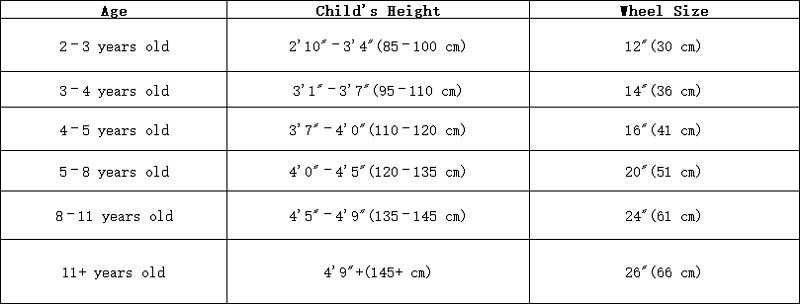
Inseam length
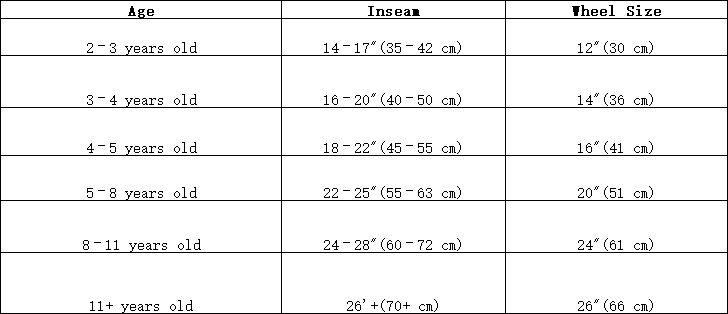
Bike sizes, types, and attributes
Children’s bikes are primarily sized by the diameter of their wheels, unlike adult bicycles, which are gauged by frame size and seat height. For young riders, the standard wheel sizes include 12, 16, 20, and 24 inches.
To put it in perspective, the wheel sizes for adult mountain bikes generally begin at 26 inches. It’s worth noting that not every brand manufactures bicycles in all these sizes, and you might encounter a handful of brands that offer bikes with 14- or 18-inch wheels.
Commonly found bike types:
balance bikes (2 to 4 years of age)
The International Bicycle Fund notes that many children start exploring two-wheelers by the age of three. For these youngsters, a balance bike equipped with 12-inch wheels is often the go-to initial option.
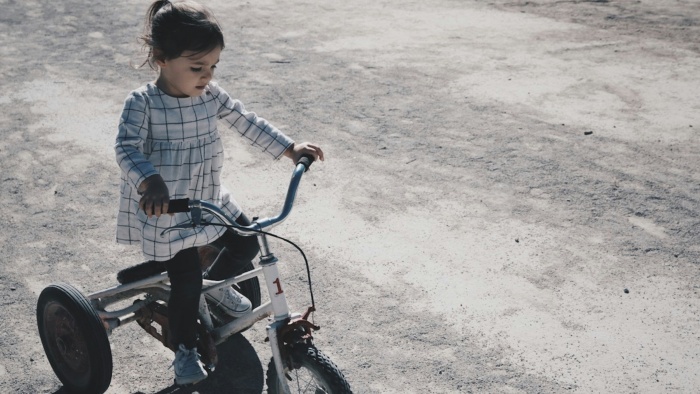
These bikes lack pedals and may or may not include a brake mechanism. Kids move the bike by pushing off the ground with their feet and halt by planting their feet firmly on the ground.
Balance bikes excel at nurturing a young child’s confidence, self-reliance, and, crucially, balance. Nowadays, they are a favored choice over tricycles or pedal bikes with stabilizers for many parents and toddlers.
Small wheelers (3 to 5 years of age)
Small wheelers act as the introductory pedal bikes for children. The term “basic” is pivotal here, indicating that most bicycles in this category are stripped of the advanced features found on larger bikes, such as handbrakes and freewheel hubs. As a bridge from balance bikes or tricycles, maintaining simplicity is advisable. Opting for a model with coaster brakes, which demand less manual skill and coordination, is a wise choice.
You’ll find small wheelers mainly with 14-inch wheels, though models with 12- or 16-inch wheels are also widespread. This variety is important for ensuring a proper fit for your child.
Middle wheelers (4 to 6 years of age)
This category, which I refer to as “middle wheelers,” might not be labeled as such in stores. These bikes are typically categorized by their wheel size, with 16 inches being a common diameter. Middle wheelers often feature hand brakes and might come with a set of gears. Some include a freewheel hub that permits pedaling in reverse. Other typical characteristics are steel or aluminum frames.
As children begin riding middle wheelers, they can achieve considerable speed, making it essential that they have the coordination and dexterity needed for balancing, steering, and operating hand brakes effectively.
20-inch wheel bikes (5 to 9 years of age)
At this level, gear sets, hand brakes, and suspension systems become increasingly common on 20-inch bikes. Additionally, you’ll start to encounter specialized terms like “road bike,” “mountain bike,” and “cruiser.” This is where specialization begins to emerge, introducing a diversity of styles and features.
This implies that careful thought must be given to the type of biking your child intends to pursue: on-road, off-road, racing, jumping, etc. Quality bicycles are an investment, and choosing a bike that doesn’t match your child’s interests can be a costly mistake.
BMX bikes
BMX bikes, another popular option within the 20-inch category, originated from the motocross motorcycle scene, initially focusing on dirt racing on tracks with jumps and banked curves. Nowadays, their appeal is much broader, largely due to their robustness and aesthetic appeal.
BMX bikes typically feature a single gear, lightweight frames, and knobby tires. While 20-inch wheels are standard, you can find BMX bikes with various wheel sizes. High-quality BMX bikes are designed to endure rough handling and are a solid choice if your child has a daring streak.
24-inch wheel bikes (7 and up)
Bikes with 24-inch wheels are often seen as a bridge to adult bicycles since they incorporate features typical of adult bikes (such as transmissions with up to 36 gears, front suspension, etc.) Road bike, mountain bike, basic cruiser styles, and BMX models are all available in this size. Advanced features, including hub brakes, are also common.
While extra features can lead to higher prices and more potential issues, the advice “the simpler, the better” holds true. However, at this stage, the decision often rests more with your child than with you.
Measuring your kid
Height: Position your child against a wall, barefoot with their feet a bit narrower than shoulder-width apart. Employ a measuring tape or a yardstick to gauge the distance from the floor to the top of their head. Jot down the measurement in inches or centimeters, depending on your preference.
Inseam: With your child standing against the wall, barefoot and feet placed a bit narrower than shoulder-width, wedge a book between their legs, spine facing upward, snug against the wall. Push the book upward until its spine firmly touches the base of your child’s crotch. Ask your child to step aside. Use a pencil to mark the wall at the point where the top of the book’s spine meets the wall, then measure from the floor to the pencil mark. Note down this measurement in inches or centimeters, as fits best.
Now that you’ve measured your child and referred to the charts, you might think it’s time to head out and buy a bike, right? Hold on. While kids bike size charts are a great first step, they’re just that. There’s still more for you to consider.
Maturity and capability
Each child is a distinct entity, different from all others. That’s a belief held by parents, and rightfully so. Parents also harbor a sense of pride, which occasionally leads them to overestimate their child’s level of maturity.
This misjudgment can pose risks. Despite what age, height, or the kids bike size chart might indicate, your child might not be ready, whether it’s due to maturity or physical capabilities, for a larger bicycle.
However, this doesn’t mean it’s entirely accurate. Your child might have reached a height that suggests readiness for a bike with larger wheels, yet may not be prepared to manage the more complex features, like hand brakes, that come with larger models.
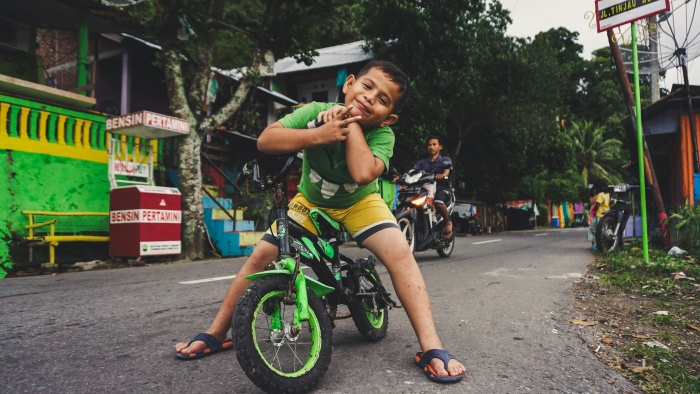
So, how do you evaluate your child’s readiness for a new bike? Firstly, no one understands your child as you do, and you have observed their performance relative to peers of the same age.
In essence, you likely possess a solid instinct regarding your child’s maturity and coordination levels. Trust this instinct, at least as a starting point. Additionally, you should have your child take a test ride before making a purchase.
Selecting your child’s next bicycle
The excitement of gifting your child a sparkling new bicycle for Christmas or a birthday is unmatched, imagining them zooming around the neighborhood, basking in the envy of their friends.
Here’s a crucial tip: hold that thought. Unless, of course, you’re ready for the possibility of having to pry your child away from their new treasure to return it, should it not be the perfect match.
When on the hunt for your child’s new bicycle, the golden rule is: bring your child along. Venturing out armed only with your child’s measurements and a kids bike size chart falls short.
To truly find the bike that’s a match made in heaven for your one-of-a-kind child, they need to physically try the bike, adjusting for fit, followed by a real-world test ride.
Your second rule of thumb during bike shopping is this: ensure the bike being tested is the exact model you intend to purchase. Ideally, you’ll want your child trying the very bike you plan to buy. If that specific bike or model isn’t on hand, it’s wise to return when it is, or explore other shopping avenues.
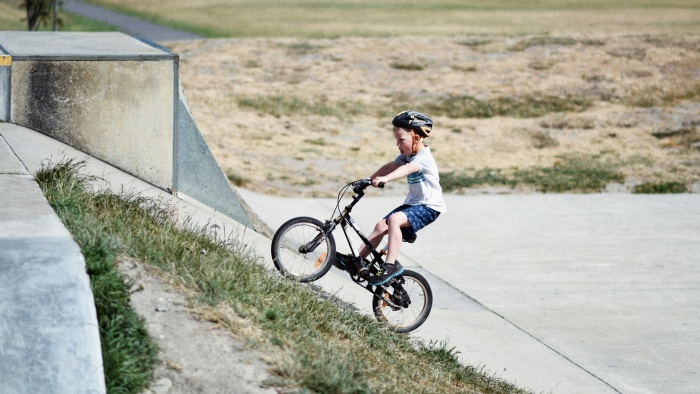
And don’t forget to bring your child’s helmet along for the shopping trip. It’s an essential part of the test ride. If your kid doesn’t have one yet, well, you’ve just identified your first purchase.
Where to shop
Your shopping venues are vast: toy and sporting goods stores, large retail chains, and discount warehouses. However, we invite you to consider our website as your premier choice.
Here, you’re most likely to encounter a wealth of knowledge and experience from our sales team, invaluable in selecting the right bicycle. Issues such as assembly and ongoing maintenance are best addressed with our expert advice.
While quality guidance and service can be found elsewhere, should you ever feel uncertain about the expertise level somewhere, we’re here, offering a trusted alternative.
Fitting the bike
Have your child sit in the saddle and reach for the handlebars. If it’s a balance bike or their first pedal bike, they should comfortably touch the ground with both feet. For subsequent pedal bikes, being on their toes while seated is what you’re aiming for.
The test ride
Take the bike outside for a test spin, ensuring your child is helmeted and the area is safe for riding. Watch how your child handles the bike, noting their comfort, balance, and confidence levels.
Encourage them to pedal, steer, turn, and brake. If the bike seems a good fit and your child is happy, you might have found the winner. Nonetheless, it’s wise to test different models for comparison.
As you inch closer to making the purchase, a final consideration: the hesitance to invest significantly in a child’s bike, given its short lifespan, is common among parents.
However, consider the benefits of opting for a higher-priced bike: better quality, lighter weight, enhanced durability, and improved control. These attributes often justify the higher price tag.
Conclusion
Selecting the right bicycle for your child might seem daunting at first, but with the aid of a kids bike size chart, the journey can become significantly smoother.
This chart is not just a tool but a starting point that leads you through the various sizes, types, and features of bikes suitable for children of different ages and stages of growth.
From balance bikes for the little ones taking their first ride without pedals to the more sophisticated models for older kids ready to explore more complex biking adventures, understanding the right fit is paramount. Remember, the ultimate goal is ensuring your child’s safety, comfort, and the joy of riding.
Therefore, while the kids bike size chart serves as an essential guide, your observations, the test rides, and your child’s excitement and comfort with the bike they choose will be the key deciding factors.
In the end, the best bike for your child is one that fits them now, supports their growth, and fuels their passion for cycling.
FAQs
What if my child is between two sizes on the kids bike size chart?
If your child falls between two sizes, it’s best to opt for the smaller size to ensure they can comfortably reach the ground and handle the bike with confidence. A bike that’s too large can be difficult for a child to control, which might affect their learning and enjoyment. You can always adjust the seat height and handlebar position as they grow.
How often should I check if my child’s bike still fits them properly?
Children grow at varying rates, so it’s wise to check the fit of their bike at least once a year. Look for signs like knees coming up too high when pedaling, difficulty reaching the handlebars comfortably, or the child’s seeming cramped on the bike. These are indications that it’s time for a bigger bike.
Can my child skip a balance bike and go straight to a pedal bike?
While many children start on balance bikes to learn steering and balancing without the complexity of pedaling, some kids may be ready to transition directly to a pedal bike, especially if they show adequate balance on scooters or tricycles. The key is to ensure the bike is the right size for their height and inseam, allowing their feet to touch the ground.
Are heavier or lighter bikes better for young children?
Lighter bikes are generally easier for children to handle and maneuver, which can boost their confidence and enjoyment. However, durability should not be compromised for the sake of lightness. Aim for a bike that’s light enough for your child to control easily but sturdy enough to withstand the rigors of learning and playing.
How important are gear systems for kids’ bikes?
For younger children and beginners, a single-speed bike is often the best choice to keep things simple and focus on the basics of pedaling and braking. As children grow and their riding skills improve, bikes with gear systems become useful, especially for varying terrains. Consider your child’s ability and the type of riding they’ll be doing when deciding on gears.

